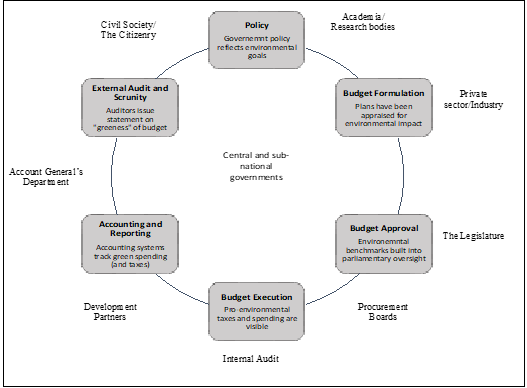Tackling climate change requires the collaboration of multiple stakeholders. Traditionally, governments have responded to environmental issues using regulation, taxation, and subsidies. Many large private sector companies, especially multinationals, utilise voluntary sustainability standards (VSS) to ensure products meet economic, social and environmental sustainability norms. A plethora of NGOs and civil society groups are involved in local conservation and habitat management.
These efforts are all relevant. But they are often done in silos, with need for greater coordination among stakeholders. Integrating elements of a landscape approach with traditional public financial management (PFM) can support a multi-stakeholder approach to environmental sustainability while also “greening” PFM.
What are landscape approaches?
A landscape approach is a conceptual framework for addressing conservation and sustainability issues. It involves the collaboration of stakeholders within a geographic ‘landscape’ to reconcile competing social, economic and environmental objectives. The concept was born out of early conservation philosophy which promoted “landscape-style” thinking regarding the biodiversity of a geographic area, as an additional step to conservation measures within a single supply chain such as cocoa. It then expanded to include people and society and their respective priorities in the landscape.
Landscape approaches have become increasingly popular in the private sector. Recent examples include its use to better manage social and environmental issues in Brazil, Mexico and Ecuador, helping to reduce emissions from deforestation and forest degradation (REDD+) and limit bio-diversity loss, and to promote value chain collaboration in the Ghanaian cocoa sector and Malaysian oil-palm industry.
Previous applications of landscape approaches have been private sector-driven, and not linked to public finance measures by national or local governments. Linking landscape approaches with PFM presents an opportunity for a comprehensive green fiscal policy, while fostering public-private cooperation
Greening PFM
Calls for “green budgeting” and using the budget for better environmental stewardship are now ubiquitous. On the ground, there have been round-table discussions on green budgeting in Asia and the Caribbean, and preliminary implementation in EU countries. The IMF has produced notes on Climate-Sensitive Management of Public Finances in a bid to promote green PFM among member countries.
These efforts are all useful for nudging governments toward a more environmentally sustainable approach to public finances – largely related to tax policy and green spending. They put government at the fore of the process – a useful development as too often climate agreements have low levels of government commitment.
But can we go further? The answer is yes. In a recent paper (Mainstreaming sustainability in public finances: where PFM meets landscape approaches), we argue that the government can use the PFM cycle to work alongside stakeholders from the private sector and communities as part of a landscape approach to tackling defined and agreed environmental targets.
When landscape approaches meet PFM
Applications of landscape approaches have produced positive results pertaining to conservation and limiting forest degradation in Latin America. However, to be truly successful, the approach should consider continuity and institutionalising the new “trajectory”. Governments are well placed to provide this function of “institutionalising” given their reach across many sectors and groups within society.
At the heart of a successful landscape approach, like other multi-stakeholder approaches, is the need for strong coordination. This is fundamental to the approach; and historically lack of sufficient coordination among stakeholders has been a major challenge. This is not surprising as applications of landscape approaches have been coordinated by private companies and NGOs, and structured around voluntary participation. How could this work in the PFM context?
As a first step, the government may use its budget to establish and resource a coordination office to bring together stakeholders in the “sustainability landscape”. Such a coordination office would host dedicated staff to: (i) engage stakeholders and work toward understanding their different interests; (ii) collaborate with other government bodies to ensure government policies (such as agriculture, health, trade and industry) are consistent with sustainability goals; and (iii) monitor performance against targets agreed by stakeholders.
The PFM cycle also lends itself to supporting a multi-stakeholder approach to sustainability if each phase of the cycle is used as an opportunity to mainstream sustainability objectives (chart below).

Research bodies and members of the scientific community can provide evidence which feeds into policymaking and budgeting - for example, informing whether subsidies for green farming should be funded, and the appropriate levels to motivate farmers. Private companies and NGOs can present credible initiatives for institutionalised backing though policy and/or financial support via the budget. For example, Voluntary Sustainability Standards (VSS) and jurisdictional compacts have been used by environmentally conscious companies, but could be enhanced through public sector support.
In the areas of budget approval and execution, building the capacity of key players can help to ensure a green budget is realised. The legislature can be sensitised on climate change mitigation so as to competently question and engage with the budget presented. Procurement boards can be trained on green procurement and lists of “green suppliers” established. Internal auditors could in turn provide checks on the application of environmental standards.
Finance ministries might adapt their chart of accounts to better track and report on green spending. Development partners can also incentivise green spending by linking it to counterpart “green” development support. Finally, external audit can build capability to comment on how “green” the actual budget performs against targets. Performance should also be reported to the citizenry, in keeping with good transparency and accountability standards. Landscape approaches provide a conducive environment for applying these PFM measures on a pilot basis in a regional or district ‘landscape’ before subsequent scaling up. The Swiss State Secretariat for Economic Affairs (SECO) are in discussions to consider piloting such an approach in the region of San Martin in Peru.
Beyond spending and taxes
The idea is simple. Yes, the government can use its fiscal policy (taxes and spending) to promote sustainability. But it can also use the budget cycle to coordinate different players in the landscape and support private/third sector sustainability initiatives. Tackling climate change requires all hands on deck. Creatively linking PFM and private initiatives through landscape approaches can help to bring those hands together.





